
Ingrown toenails are undoubtedly painful and frustrating, especially if you continue to get them over and over. While there are many causes of ingrown toenails, such as picking or pulling at the nails, or trimming the toenails too far down the sides of the nail to give them a curved appearance, one causative factor that is often overlooked is the shoes you wear. Specifically, wearing shoes that are too tight – and in some cases even too loose can cause your toenails to grow down into the skin, leading to yet another ingrown toenail. So what should you be looking for in shoes that help protect your feet against ingrown toenails? Here are five great places to start.
Get the Right Fit
The first step in choosing the right shoes to avoid ingrown toenails is to make sure your footwear is the right fit – and style – for your foot type. Tight shoes can cause ingrown toenails by putting pressure on the toes, which can push the toenails into the skin. When the toenails are constantly pressed against the skin, they can become inflamed and swollen, making it easier for them to grow into the skin. Additionally, tight shoes can cause the toes to be compressed, which can lead to an imbalance in the pressure distribution in the toes. This can cause the toenails to grow abnormally, making them more likely to become ingrown.
When shoes are too loose, the foot can slide forward inside the shoe, causing the toes to press against the front of the shoe. This can lead to the toenails being pushed into the skin, especially if the shoes are repeatedly worn without being properly adjusted or tightened. Loose shoes can also cause the foot to move around inside the shoe, which can cause the toenails to rub against the inside of the shoe or each other. This friction can irritate the skin around the toenails and make it more likely for the nails to grow into the skin.
When you’re buying shoes, make sure you try them on and walk around in them to see how they feel. You should be able to wiggle your toes comfortably, and there should be enough space between the end of your shoe and your longest toe.
Choose Shoes with a Wide Toe Box
Shoes with a narrow or pointy toe box can squeeze your toes together, causing your toenails to grow into the skin. Instead, look for shoes with a good-sized toe box. They don’t even have to be super wide – just suitable for your foot and foot type. This will allow your toes to spread out naturally. Shoes with a rounded or square toe box are a good starting point to help give your toes the space they need. If you have wide feet or bunions, you may need to look for shoes that are specifically designed for these conditions – but thankfully today’s market has a lot of variation and options for those with a range of foot conditions.
Look for Shoes with Soft, Flexible Uppers
The material of the shoe’s upper can also affect how your toenails grow. Shoes with stiff, rigid uppers can put pressure on your toes, causing them to curl under and grow into the skin. Look for shoes with soft, flexible uppers that allow your feet to move naturally. Leather and mesh are good options as a starting point.
Avoid High Heels
High heels not only overload your forefoot which can lead to a range of pains and problems, but they can also contribute to the development of ingrown toenails. High heels force your toes into the front of the shoe, putting pressure on your toenails and causing them to grow into the skin. If you must wear heels, look for shoes with a lower heel height and a wider toe box.
Consider Orthotics
If you have flat feet or other foot problems, and have had a pair of orthotics in the past, you may benefit from continuing to wear them as a way to help prevent your ingrown toenails from recurring. While orthotics are typically designed to support your feet and improve your foot alignment, they can also help prevent ingrown toenails by reducing pressure on your toes through the way that foot alignment is adjusted.
Getting Help For An Ingrown Toenail
If you’re concerned about recurrent ingrown toenails and aren’t sure if your shoes are the source of the problem or if it’s something else, we can help. Our team offers treatments that fix both one-off and recurrent ingrown nails, as well as helps you get to the cause of the problem to help prevent them from continuing to cause you pain and discomfort in the future.
Book your appointment by calling us on 09 523 2333 or book online here.

As a clinic specialising in ingrown nail care and treatment, we often see patients who have been battling with an ingrown toenail for many weeks and come to us to finally get rid of the problem. During the appointment, it’s surprisingly common to hear: “but I went to my doctor and got antibiotics – I’m not sure why they didn’t work?”
The reason they didn’t work is because antibiotics are fantastic when it comes to treating infections caused by bacteria – but ingrown toenails are unfortunately a mechanical issue caused by the growth of the toenail into the surrounding skin. While an ingrown toenail can become infected, antibiotics would only be effective in treating the infection and would not address the underlying issue of the toenail growing into the skin. Hence, your ingrown toenail continues to persist and cause you pain while putting you at risk of recurring infections, given that the wound never gets a real chance to close and heal.
How Can You Tell If Your Ingrown Toenail Is Infected?
Some signs that an ingrown toenail may be infected include:
- Redness and swelling around the edge of the toenail
- Drainage of pus or other fluid from the area
- Warmth and tenderness to the touch
- Pain, especially when pressure is applied to the area
- A fever, which is a sign of a systemic infection
If My Ingrown Toenail Is Bleeding, Does That Mean It’s Becoming Infected?
No. Ingrown toenails often bleed because a sharp piece of nail has broken the surrounding skin and is now growing into it. But if your toenail is bleeding, it does mean that you’re at risk of developing an infection. This is why it’s important to get your ingrown toenail treated promptly. Before you can get in to see a podiatrist, keep the affected area clean and dry, and avoid picking at or squeezing the nail or surrounding skin, as this can increase the risk of infection.
What Is The Best Way To Treat My Ingrown Toenail?
The best treatment option for you will depend on the cause of your ingrown toenail, its severity, and whether this is your first time with an ingrown toenail or the nail is a repeat offender.
Here at the Auckland Ingrown Toenail Clinic in Remuera, we treat ingrown nails in one of three ways:
- Conservative nail care: for first time ingrown toenails, as well as for those where the cause is unlikely to recur again in the future, our podiatrists are able to remove the offending nail spicule using our specialised surgical instruments, simply and easily. We will then provide you with a series of instructions on how to trim your nails in the future to reduce your likelihood of the problem returning. For tips on what not to do for an ingrown toenail, read this article.
- Partial nail avulsion: for recurring ingrown toenails, our podiatrists specialise in removing the offending nail spicule permanently. This uses a chemical to prevent the problematic edge of the nail from growing back in the future, while giving you instant relief when the nail is removed from the skin.
- Total nail avulsion: for recurring ingrown toenails that have a secondary problem, like a thickened, damaged or distorted nail, we can perform a total nail avulsion. This involves removing the entire nail and allowing it to grow back naturally, ideally without the previous issues.
Auckland’s Ingrown Toenail Experts
If you have an ingrown toenail and need help, get in touch with our ingrown toenail experts located inside the One Health building on Remuera Road, close to Newmarket. You don’t need to have been taking any antibiotics prior to your appointment. Our podiatrists will assess your toe and present you with a series of options to help you get the best outcome and much-needed pain relief.
You can book your appointment online or by calling us on 09 523 2333

So you’ve got toe pain starting but you’re not sure if it’s an ingrown toenail. What are the signs you should be looking for if it’s an ingrown toenail and what else could be the cause of your toe pain? Our ingrown nail specialists share what we look for in an early ingrown toenail.
What Does An Ingrown Toenail Look Like In The Early Stages?
When an ingrown nail first starts, it means that a sharp edge or spicule from the nail has recently pierced and penetrated the skin next to the spicule – even just slightly. This means that when any pressure is put on the nail, whether from being squeezed, from footwear, or even the natural vibrations through the feet when we walk, we can feel pain or discomfort. As the nail spicule has only recently pierced the skin, the skin surrounding the nail may not be red or inflamed, like is typically pictured in images of ingrown nails.
The location of the nail spicule may be deep down in the nail, or toward the top of the nail in the corner – this really depends on where the spicule or sharp edge developed. Often, the spicule is deep down the side of the nail, deeper than the eye can see, meaning at the early stages it’s barely noticeable. What may give an ingrown toenail away in the early stages in a build-up of callus down the side of the nail – this can indicate that the nail edge has been rubbing against the skin for some time, and has finally penetrated.
All in all, an ingrown nail in the early stages may not look so different from an unaffected nail. You can still have an ingrown toenail without any bleeding, swelling, redness or any discharge from the toe. The key is the pain when pinching the toe – if you get sharp, localised pain when pinching the toe, it could be the start of an ingrown toenail.
When Ingrown Nails Get Worse
As your ingrown nail gets worse, you can expect to see swelling and redness. The swelling is a catch-22 – the more swelling, the more the skin pushes against the nail and the deeper the nail enters the skin, which causes more swelling. The swelling will be present on the side of the nail where the nail has grown into the skin. If you have swelling on both sides of the nail, two of the sides have ingrown, which is not uncommon if the cause of the ingrown toenail is linked to a curved nail shape, among other causes. Sometimes, multiple toes can have ingrown toenails at the same time.
You may also notice:
- Increasing pain at the toe, especially when squeezed
- It becomes difficult to wear tighter shoes that push on the toes
- Clear or yellow discharge from the ingrown nail site, which can indicate an infection
- Bleeding from the ingrown nail site
If It’s Not An Ingrown Toenail, What Else Could It Be?
While ingrown nails are usually distinctive and common, similar toe pain can also because by:
- Callus build up on the toe, by the nail, but without the nail piercing the skin
- A foreign body like a splinter piercing the skin at the toe
- Damage to the nail and nail bed from trauma – like from stubbing your toe
- Toe fracture, which affects the toe bone beneath
- A cyst or a clogged sweat gland may be present in the area
What Should I Do If I Think I Have An Early Stage Ingrown Toenail?
An ingrown toenail caught in the early stages is the perfect time to nip it in the bud and treat it – before it gets worse. Leaving an ingrown toenail without care will lead to the inevitable – as your toenail naturally grows, the nail spicule or sharp edge will grow deeper into the skin, amplifying your symptoms. Treating it early saves you a lot of pain from the inflammation and symptoms that follow.
Treating your ingrown toenail should be done professionally – and is our area of expertise. We love early ingrown toenails because thanks to our state-of-the-art tools, we can get it quickly, safely, easily and relatively painlessly compared to a late-stage ingrown toenail. If you’re concerned about pain, we also have the option of numbing the area too.
We’ll also discuss the likely reasons that your ingrown nail has occurred, and what you can do to reduce the likelihood of it happening again in the future. We also have permanent treatments to stop the nail edge from growing back into the skin – we’ll discuss all your options at your consultation.
Book your appointment by calling us on 09 523 2333 or book online.

Every so often, we have a patient come to our clinic with a severe ingrown toenail that had started weeks ago – or sometimes even months ago. The reason for waiting so long in pain? They were waiting for it to grow out.
Truthfully, the idea that an ingrown toenail will just ‘grow out’ if it’s left for long enough is inaccurate – and has led many people to endure a lot of pain. Here’s what really happens when you leave your ingrown toenail untreated.
The Nail Will Keep Growing Deeper Into The Skin
Given that the hard nail sits on top of our toe, it’s easy to think that the painful ingrown area is along the surface of the nail too, and so will easily grow out in time, taking the pain away with it. In most of the cases we see, the reality is quite different. The ingrown portion of the nail, which we call the nail spicule, is usually located quite deep down the side of the nail – often much deeper beneath the swollen skin than you can visibly see. Waiting for your nail to grow out then means driving this nail spicule deeper into an already tender toe.
Given that toenails grow much slower than fingernails at an average rate of 1.62mm per month, and you may have multiple centimetres of skin to go through, this can mean months of severe pain, difficulty wearing shoes – and the risk of infection.
Your Toe Can Become Infected
An ingrown toenail is when the nail spicule has pierced your skin, leaving an open wound. Open wounds are susceptible to infection for the entire time before they heal, and given the proximity of the feet to the dirtier ground, you’re left with a significant risk of infection and further pain.
Treating infections isn’t always as simple as picking up a script for antibiotics, either. While antibiotics can treat simple infections, if your infection spreads to the toe bone or becomes complicated, antibiotics may not be enough, and you may develop conditions like gangrene, sepsis or osteonecrosis (bone death).
The Vicious Cycle
Another problem with leaving ingrown toenails untreated is the snowballing cycle of pain and swelling. When an ingrown nail first starts, it grows into the skin, swelling develops. The swelling puts more pressure on the nail, driving the ingrown spicule deeper into the nail. As it grows deeper, the swelling continues and may worsen, further aggravating the problem.
Ingrown Toenails Can Only Heal Once The Nail Spicule Is Removed
The only way to stop the swelling/pain cycle, remove the risk of infection, and stop the problem worsening is to remove the often small nail spicule from the skin. Once it is removed, the skin can heal, the swelling can go down, and you can get back to painless walking.
How Are Ingrown Toenails Treated?
Here at the Auckland Ingrown Toenail Clinic, our experienced podiatrists make treating ingrown toenails easy, simple and painless. Using local anaesthetic (if you want it), we remove the offending nail edge from where it is lodged in the skin, trimming that part of the nail that often lies deep beyond where you can see without the right instruments and experience.
We can either do this as a one-off, best suited for first-time ingrown toenails that are unlikely to come back, or as a permanent solution, taking extra steps to stop the problematic nail edge from growing back again – and eliminating the risk of another ingrown toenail in the future. Read about both of these services here.
Don’t Delay Treatment
The faster you have your ingrown nail treated, the better for your health and easier for your recovery. Book your appointment by calling 09 523 2333 or book your appointment online.
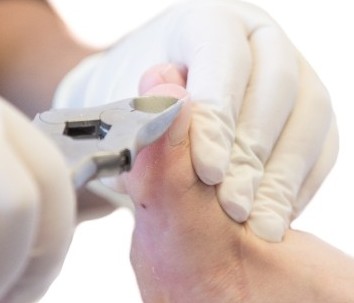
 Recently over our lockdown period, as we were unable to see patients under our higher alert levels, the questions around ingrown toenails came rolling in. A lot of the queries came after people had tried fixing their ingrown toenail at home. Some felt their pain had become worse, for some it stayed the same – and most people just wanted to know what they could do to help get some relief until the restrictions eased.
Given the number of people that tried fixing their nail at home first, we thought we’d share our tips for what NOT to do when you have an ingrown toenail, in case you find yourself in a situation again where you can’t get to your podiatrist for one reason or another.
Recently over our lockdown period, as we were unable to see patients under our higher alert levels, the questions around ingrown toenails came rolling in. A lot of the queries came after people had tried fixing their ingrown toenail at home. Some felt their pain had become worse, for some it stayed the same – and most people just wanted to know what they could do to help get some relief until the restrictions eased.
Given the number of people that tried fixing their nail at home first, we thought we’d share our tips for what NOT to do when you have an ingrown toenail, in case you find yourself in a situation again where you can’t get to your podiatrist for one reason or another.
1. Don’t Rip The Nail Off
When you pick, pull or rip the toenail, though it may seem like a way to get the nail off deeper than you can see, it very rarely helps an ingrown toenail – in fact, it’s often the original cause of ingrown toenails. As you get to the end of the nail and you pull it off, the nail often leaves behind a jagged edge where it is pulled. As it grows, this sharp spicule penetrates the surrounding skin and causes an ingrown toenail.
2. Don’t Cut Deep Down The Side Of The Nail, Beyond What You Can See
Toenails should be cut straight across, following the natural curvature of the toenail. They should not be cut down the side of the nail, as this encourages ingrown toenails. Often, the skin beside an ingrown toenail will swell and start to overlap the nail. This makes it difficult – and painful – to trim a toenail and see what you’re doing – and whether you’ve gotten all of the nail, or have left behind a piece of the nail – or even formed a new nail spicule to cause you pain in the future.
3. Don’t Cut A V In The Middle Of The Nail
It used to be thought that cutting a V in an ingrown toenail could help fix an ingrown toenail by encouraging the nail to grow more towards the centre of the nail to fill the V. Now we know this isn’t true and isn’t helpful. In fact, cutting the V and leaving the nail without proper treatment may worsen the situation as the nail can become infected, or the existing infection may worsen.
4. Don’t Wear Tight Shoes
Not only will it be painful, but it may push the sharp nail spicule further into the skin, causing more damage.
5. Don’t Rely On Painkillers, Antibiotics Or Other Medications To Fix The Problem
An ingrown toenail is caused by a piece of nail entering and growing into the skin. It’s a physical problem that can be relieved by carefully removing the offending piece of nail. Sometimes, rubbing from the nail may even cause a tiny corn in the area, which needs to be removed too for the pain to go away.
Medications do not fix a physical problem like this. Painkillers will help relieve your pain temporarily, but the issue remains, so the pain will come back. Antibiotics can help manage any infection present in the area, or help prevent an infection, but they do not solve the problem of the nail being lodged in the skin. Other medications, like those that bring swelling down, can help give you some relief from the pain by reducing the swelling at your toe. Again, it doesn’t fix the problem. By all means, use medications to help get some relief before you’re able to get proper help, but don’t expect the problem to be fixed and always see your podiatrist as soon as you can.
6. Don’t Let Your Feet Stay In A Damp, Moist Environment
As ingrown toenails occur when a piece of nail pierces the skin, this break in the skin is vulnerable to infection. Bacteria and fungus breed best in dark, warm and moist environments. So don’t leave your feet in these conditions while you have an active ingrown toenail. Dry your feet well and let them breathe.
7. Don’t Attempt ‘Bathroom Surgery’
Finally, don’t try bathroom surgery at home – meaning digging deep into your ingrown toenail while your toe bleeds or you’re in agony. As podiatrists that specialise in ingrown toenails, we have years and decades of experience in detecting and removing ingrown nail spicules. They’re often deep and difficult to see – if you can even see them at all. Sometimes they grow softer and more breakable due to the moisture from piercing the skin. Other times they’re accompanied by a small corn that also needs removal. We see a lot more nails go wrong than right with bathroom surgery, and the nail ultimately becomes more complicated to treat once you get into the clinic. So we recommend avoiding this altogether.
Auckland’s Ingrown Toenail Experts
What you should do is to book in with our experienced podiatrist as soon as alert level restrictions allow. Once it is safe to see you according to the government’s recommendations and the advice we receive from the Podiatry Board, we will prioritise getting you in urgently to care for your ingrown nail.
If you need an appointment for an ingrown toenail ASAP, book yours by calling us on 09 523 2333. Email us here if we’re currently not operating due to lockdown restrictions and you want us to contact you ASAP once we can operate.
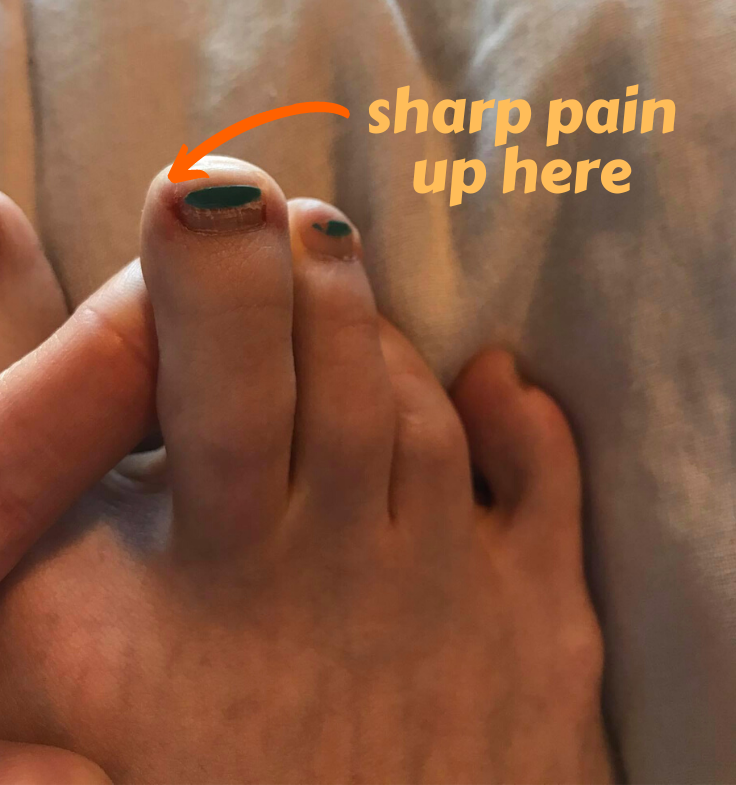
We had a patient come in to see us recently with the tip of her second toe being red, feeling tender and looking a little swollen. She had experienced ingrown toenails previously, and said it felt a little bit like that. Except this time, she had cut her toenails short a week or so prior – and the area that was painful wasn’t immediately down the side of her nail but above it, where the nail used to be before she cut it.
She wasn’t sure what was going on, if it was an ingrown nail, or if it was something else. We thought we’d share what happened in case you’re also feeling like you’ve got pain towards the top of your toe but your nails are trimmed short and the area of the pain isn’t where you’d expect, so you’re wondering whether it could still be an ingrown toenail or what could be causing your toe pain.
The actual toe pictured below (just for reference), about a week after we successfully treated it:
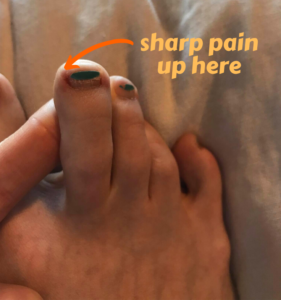
Second toe pain: Our patient’s story
When we examined her toe, it was extremely tender to touch in a particular spot only – and it wasn’t the toenail. (Note: pushing down on the toenail did cause a bit of pain, but only from the way that the pushing affected the painful area at the top of the toe). There was a small indent at the top of the toe where the pain was, and the entire tip of the toe was a little reddened and mildly swollen. Very tender to touch.
Examining the part that had indented, we found two things:
- A small corn in the crease – the skin was harder and firmer than the soft surrounding skin
- A small piece of the nail that had embedded into the nail crease – the crease created in the skin from the previous length of the toenail before it was trimmed
Understanding how this develops, we could see that the nail must have been rubbing against the skin when it was long for some time, which both produced the corn, and encouraged the edge of the nail to become embedded into the skin. Eventually, a small piece of the embedded nail broke off, and was left behind as it was trimmed.
Instant pain relief from treatment
If there’s anything good to come out of this case, it’s that for this patient, her treatment was quick and effective, with the sharp stabbing pain easily instantly after we removed both the embedded nail spicule and the small corn. This is because the swelling, redness and pain was a direct result of the nail spicule still being left behind, which was then made worse by the corn – so once we could remove both of these, the toe would be able to heal and any swelling and pain would subside.
This is a common mistake we see when patients treat their nails at home – they may trim their nails, but forget that while something foreign (and sharp!) is piercing the skin, the wound cannot close and heal. Getting it out can be tricky because the nail spicule can be difficult to see, difficult to remove, and painful when you’re using whatever you have at home to try to help, instead of our fine, specialised podiatric tools.
Within 5 minutes, we were able to remove the nail spicule, remove the corn completely, and then dress the toe. Our patient had immediate relief from the sharp stabbing pain, and while some tenderness lingered as there was still a small wound there, this had subsided by the next morning, along with the redness and swelling.
Our podiatrists make treating all sorts of ingrown toenails easy
We wanted to share this because while many ingrown toenails are ‘textbook’ – big toenail, down the side of the toe – as ingrown toenail specialists, we see plenty of ingrown toenails that are atypical, but that are still very effectively and simply treated.
We’re equipped with all the right tools to make treatment easy and stress-free, and unless you require ingrown nail surgery, can almost always treat and relieve your pain on the day. (If you require surgery we’ll always book you in for it as quickly as possible!).
Book your appointment with us by calling 09 523 2333 or book online here.
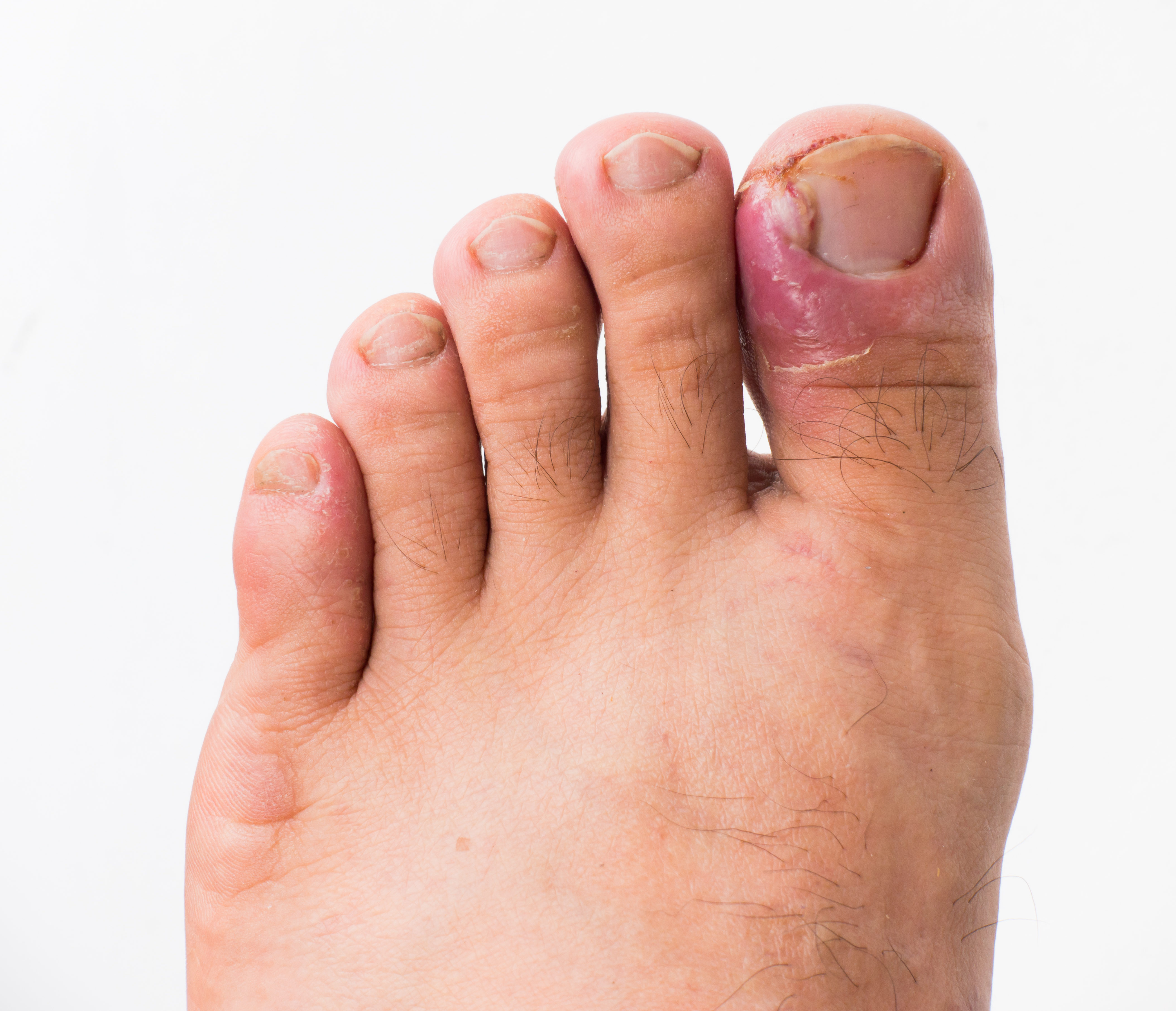
Ingrown toenails are painful and frustrating enough, so the last thing you want is to add an infection to the mix. Unfortunately, in our experience, a large number of ingrown toenails will get infected if proper treatment is undertaken – and it makes sense when you think about it.
Today, our ingrown toenail specialists will be sharing:
- Why the risk of developing an infection once you have an ingrown toenail is high
- What you can do to prevent an infection before it develops
- How you can treat your ingrown toenail and infection once it has occurred
You Have A Significant Risk Of Developing An Infection. Here’s Why
Let’s clear something up: ingrown toenails and infections are not a case of the chicken and the egg – the ingrown toenail comes first.
What classifies a sore toe as an ‘ingrown toenail’ is the moment that the sharp piece of nail goes from merely pushing against the surrounding skin, to actually piercing it and penetrating it.
Think about that for a second – you have a piece of nail that is now constantly inside the skin through a cut down the side of the nail. Every time you walk and move, it’ll move slightly with vibrations of pressures from shoes and socks. Ouch! This also means that while a normal cut occurs and then can heal, this cut can’t – because the ingrown toenail is still constantly piercing it and so keeping the cut open.
An infection occurs when bacteria and other nasties enter the body. Usually, our skin is a fantastic barrier, so while there may be many nasties around us regularly, they never have an ‘in’. Until now. And especially at the ground where you may walk barefooted. And when you give it a perfectly placed entrance – there’s a strong chance that the infection will take hold and start to develop.
Once the infection takes hold, it means increased swelling, pain and oozy discharge (and maybe blood) that is yellow/green/clear in nature and may ‘crust over’.
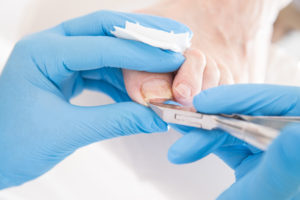
Preventing An Infection From Your Ingrown Toenail Before It Develops
So how, then, can we prevent – or at least reduce the risk – of developing an infection? It’s quite simple, really. And no – no Epsom salts required just yet!
As the cut from ingrown toenail creates an ‘in’ for the bacteria to take hold, the way to prevent an infection is to remove this ‘in’. This means removing the penetrating nail edge so that the cut can heal, close, and no longer be vulnerable to the infection. Simple, right? – Absolutely.
So How Do I Treat My Ingrown Toenail – And The Infection If I Already Have One?
The best way to ensure the proper care of your ingrown toenail is to see your Podiatrist. Our team here at the Ingrown Toenail Clinic are Podiatrists that are trained in simple and painless ingrown toenail surgeries, as well as conservative care where we safely remove that small, pesky nail edge in a matter of minutes. You’ll feel the relief almost instantly!
We don’t recommend trying to cut back the nail at home because often the nail runs much deeper than you can see, so most people will miss removing the complete penetrating edge and their pain will only continue to worsen. You also won’t have the right tools for the job – whereas we have everything needed to do it quickly and easily – even anaesthetic if you need or want it! (though most people don’t).
Once the sliver of nail is removed, the body will be able to effectively heal the wound and fight the infection – and of course, we’ll help it along by dressing it with betadine (antiseptic). You’re welcome to soak it in some Epsom salts too – but once the nail is out, it should be relatively simple and straightforward for it to heal and the infection to subside.
No more painful, swollen discharge – hooray!
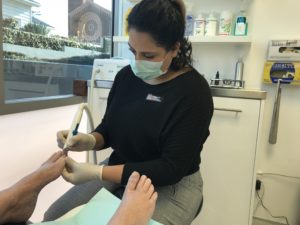
Auckland’s Ingrown Toenail Experts
We’re proud to be Auckland’s only Podiatry clinic that specialises in the safe and effective care of ingrown toenails – and we do a really good job of it. From simple and easy care to quickly remove the small nail edge, to minor nail surgery to permanently correct ingrown toenails, we’ve got you covered.
You can book online here or give us a call on (09) 523 2333.






 Recently over our lockdown period, as we were unable to see patients under our higher alert levels, the questions around ingrown toenails came rolling in. A lot of the queries came after people had tried fixing their ingrown toenail at home. Some felt their pain had become worse, for some it stayed the same – and most people just wanted to know what they could do to help get some relief until the restrictions eased.
Recently over our lockdown period, as we were unable to see patients under our higher alert levels, the questions around ingrown toenails came rolling in. A lot of the queries came after people had tried fixing their ingrown toenail at home. Some felt their pain had become worse, for some it stayed the same – and most people just wanted to know what they could do to help get some relief until the restrictions eased.



